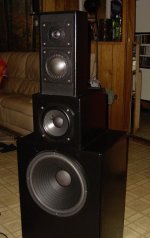You have quite some points I strongly agree to.
On the other hand, it is kind of a personal thing. There are enough people out there that can finish a cabinet in a quality that is as good or better than commercial builds. In the rare cases where such skills meet a wise mind, that knows where not to get creative and stick to a plan of a good kit, this hobby is very rewarding. The objective results can outperform speaker that cost ten times as much finished.
Random listeners often comment about the good sound of my DIYS products and ask what brand and price they are. They mostly don't realize it is DIYS until told. Maybe because I focus on good sound, not spectacular optics and extreme audio effects.
You mentioned the point of selling a DIYS speaker. It depends. If it looks like a bunch of unfinished wood parts, you are right. It will not even sell for the cost of chassis.
Surprisingly I sold many of my builds for fair prices, covering the cost of material and even a little more. To people that asked me to sell them after listening, not because they were on sale. I always insist on trying them at home first, because I don't want any negative comments later.
I don't build speaker or electronics with the intention to sell them later, but with the idea of ending up with something worth much more than I could ever buy finished. Also, I know my limits. There are projects that are to large for me, as try and error would exhaust my time and monetary budget. So I only take on things that I can safely handle and never set any time limit when to finish. Hobby with a time line is no good IMO. Sometimes projects need years, because other things are more important.
If you know your tools, you can have your wood cut to size at a hardware store, veneer them with an irons and finish off with a can of spray paint.
Not anyone has the hands and mindset to realize something close or equal to professional work with such low tech tools.. The internet has made learning much simpler, I had to "steal" my knowledge from pro's by watching them at work.
So in the end it depends on the individual person. Overconfidence is no recipe to a DIYS High End speaker, that's for sure.
On the other hand, it is kind of a personal thing. There are enough people out there that can finish a cabinet in a quality that is as good or better than commercial builds. In the rare cases where such skills meet a wise mind, that knows where not to get creative and stick to a plan of a good kit, this hobby is very rewarding. The objective results can outperform speaker that cost ten times as much finished.
Random listeners often comment about the good sound of my DIYS products and ask what brand and price they are. They mostly don't realize it is DIYS until told. Maybe because I focus on good sound, not spectacular optics and extreme audio effects.
You mentioned the point of selling a DIYS speaker. It depends. If it looks like a bunch of unfinished wood parts, you are right. It will not even sell for the cost of chassis.
Surprisingly I sold many of my builds for fair prices, covering the cost of material and even a little more. To people that asked me to sell them after listening, not because they were on sale. I always insist on trying them at home first, because I don't want any negative comments later.
I don't build speaker or electronics with the intention to sell them later, but with the idea of ending up with something worth much more than I could ever buy finished. Also, I know my limits. There are projects that are to large for me, as try and error would exhaust my time and monetary budget. So I only take on things that I can safely handle and never set any time limit when to finish. Hobby with a time line is no good IMO. Sometimes projects need years, because other things are more important.
If you know your tools, you can have your wood cut to size at a hardware store, veneer them with an irons and finish off with a can of spray paint.
Not anyone has the hands and mindset to realize something close or equal to professional work with such low tech tools.. The internet has made learning much simpler, I had to "steal" my knowledge from pro's by watching them at work.
So in the end it depends on the individual person. Overconfidence is no recipe to a DIYS High End speaker, that's for sure.
Hello IanThe low frequency electrical assisted EQ used in JBL M2 monitor isn’t absolutely necessary for consumer hifi use.
No but it doesn't hurt to have it as an option. I get pressurization until the sweep stops at 20Hz and it's selectable from off +3, +6 So if your source material has any real extension below 40Hz it's a plus.
When l start listening at 6.00 pm and are still up till 2.00 am in the morning captivated by my favourite tunes l think it’s a good sign.
I did the same 6 to 2 so I know what you mean! Always a good thing.
Rob 🙂
Hi Patrick,
The tone of your post is a little off.
The snipe at Tekton completely un necessary, unfounded and its old news.
I have no affiliation.
https://www.stereophile.com/content/tekton-moab-be-loudspeaker
Heckling won’t win you admission on Diyaudio.com.
Just wondering why you hadn’t actively contributed earlier at the outset of this thread.
The tone of your post is a little off.
The snipe at Tekton completely un necessary, unfounded and its old news.
I have no affiliation.
https://www.stereophile.com/content/tekton-moab-be-loudspeaker
Heckling won’t win you admission on Diyaudio.com.
Just wondering why you hadn’t actively contributed earlier at the outset of this thread.
Absolutely,Hello Ian
No but it doesn't hurt to have it as an option. I get pressurization until the sweep stops at 20Hz and it's selectable from off +3, +6 So if your source material has any real extension below 40Hz it's a plus.
I did the same 6 to 2 so I know what you mean! Always a good thing.
Rob 🙂
I am enjoying it before l get my teeth into the real build. Without even trying streaming the numerous YouTube artist tributes shone a light on its capabilities. Btw my JBL Synthesis sdp-58 processor worked out.
Ian
While l contend l don’t generally aim at furniture grade finishes to my diy loudspeakers l don’t believe it’s difficult to obtain a worthy outcome with patience, perseverance and an understanding of how to use your tools correctly.
I am also not sure why l would want to flip one of my diy loudspeakers. I don’t get it. My oldest my original JBL 4343 project is now 45 years old and is still going strong.
What l do have is some low frequency enclosures in 5 cu ft and 8 cu ft sizes that l use as prototypes for evaluating different drivers. Using modular approach by stacking a midrange driver enclosure or a horn above the main enclosure l can get a good idea of a project at the outset before proceeding with a final build.
What this does is it allows a diy builder the opportunity to explore a few different possibilities without being locked into a baffle layout or an enclosure plan.
The upshot is that you end up with some well evolved systems that you want to keep as opposed to a garage full of discarded projects that didn’t turn out.
I am also not sure why l would want to flip one of my diy loudspeakers. I don’t get it. My oldest my original JBL 4343 project is now 45 years old and is still going strong.
What l do have is some low frequency enclosures in 5 cu ft and 8 cu ft sizes that l use as prototypes for evaluating different drivers. Using modular approach by stacking a midrange driver enclosure or a horn above the main enclosure l can get a good idea of a project at the outset before proceeding with a final build.
What this does is it allows a diy builder the opportunity to explore a few different possibilities without being locked into a baffle layout or an enclosure plan.
The upshot is that you end up with some well evolved systems that you want to keep as opposed to a garage full of discarded projects that didn’t turn out.
Patrick is not heckling but it's a point of view in this stage of his life and he has made a large contribution to this forum over the years. I've already mentioned previously in this thread that the journey has been the most important part of diy for me.
It's almost impossible to give away diy projects in Australia let alone sell them and if you have a look at the swap meet for my free stuff you will notice that. Luckily I was able to find homes for many but binned a lot of drivers and components. Since I built scores of speakers and amps, I couldn't hang onto them forever.
I agree with Patrick that commercial speakers are getting better in sound and value and recently purchased 2 for prices I could not compete with even though I buy drivers and parts at trade prices. The price of drivers and crossover parts have increased dramatically in Australia.
I really enjoyed diy but now have moved on for various reasons with some being out of my control. I would never discourage anyone doing this hobby as it's very fullfilling and enjoyable but be aware of it's issues and costs.
It's almost impossible to give away diy projects in Australia let alone sell them and if you have a look at the swap meet for my free stuff you will notice that. Luckily I was able to find homes for many but binned a lot of drivers and components. Since I built scores of speakers and amps, I couldn't hang onto them forever.
I agree with Patrick that commercial speakers are getting better in sound and value and recently purchased 2 for prices I could not compete with even though I buy drivers and parts at trade prices. The price of drivers and crossover parts have increased dramatically in Australia.
I really enjoyed diy but now have moved on for various reasons with some being out of my control. I would never discourage anyone doing this hobby as it's very fullfilling and enjoyable but be aware of it's issues and costs.
While l contend l don’t generally aim at furniture grade finishes to my diy loudspeakers l don’t believe it’s difficult to obtain a worthy outcome with patience, perseverance and an understanding of how to use your tools correctly.
Agreed you can get some fairly decent out comes if you take your time and are patient. Just a couple of coats black of paint over MDF. Or vernier if you decide.
Rob 🙂
Attachments
What a terrible response to a perfectly normal and valid post by Patrick, who has been a very positive contributor to this forum for many years.Hi Patrick,
The tone of your post is a little off.
The snipe at Tekton completely un necessary, unfounded and its old news.
I have no affiliation.
https://www.stereophile.com/content/tekton-moab-be-loudspeaker
Heckling won’t win you admission on Diyaudio.com.
Just wondering why you hadn’t actively contributed earlier at the outset of this thread.
If there is any place where the "tone is off" it's in your post, not his.
You also should look up the definition of "heckling" before using it, since you clearly don't understand what it means.
Hi Patrick,
The tone of your post is a little off.
The snipe at Tekton completely un necessary, unfounded and its old news.
I have no affiliation.
https://www.stereophile.com/content/tekton-moab-be-loudspeaker
Heckling won’t win you admission on Diyaudio.com.
Just wondering why you hadn’t actively contributed earlier at the outset of this thread.
It's "old news?"
It happened less than five months ago.
https://www.google.com/search?q=tekton+threatens+litigation
Also, I've made 7,410 posts on diyaudio over the last sixteen years, not sure why I'd need an invite to contribute. I post using the same username on diyma , and all of the other major forums. I've invested a lot of time and effort in this community, IMHO.
It's almost impossible to give away diy projects in Australia let alone sell them and if you have a look at the swap meet for my free stuff you will notice that. Luckily I was able to find homes for many but binned a lot of drivers and components. Since I built scores of speakers and amps, I couldn't hang onto them forever.
I thought it was incredibly cool that Bill Waslo gave away boxes of equipment a few years back.
I recently sold some speakers on Facebook, and when the dude came to pick them up, I learned he was living out of his van.
I asked him to wait a few minutes, drove up to my house, and brought him boxes more and just gave them away. I would much MUCH rather see someone get some good use out of these amplifiers and drivers, and I once crunched the numbers and realized that at the rate that I build speakers, it would take something like 700 years to actually USE all the drivers I have.
I am an the worst kind of hoarder and my collection of speakers is getting completely out-of-hand.
The main thing that's been a struggle where I live, is that our audio community is basically non-existent here. It's a bit ironic because we have some fairly well known manufacturers. IIRC, Dan Wiggins from Adire Audio used to have the Brahma subs built by a build house out here in Vegas. Dan Wiggins relocated here recently, he has a shop but I haven't seen it. I believe "O Audio" is the new name for the build shop that used to build the Adire Brahma subs. (Don't quote me on that, it's been 20 years since Adire was selling them.)
Due to the nearly complete lack of a high end DIY community here, even trying to GIVE my stuff away would likely be a struggle, unfortunately. But it seems kinda tragic to just throw this stuff in the trash, and the cost of shipping these days makes it nearly impossible to get rid of them on eBay.
Geddes once observed that he noticed his speakers appeal to engineers and I think there's a lot of truth in that. When I lived in Seattle, there were TONS of people who were active in the hobby, and there's a bunch up in Vancouver BC too.
The Tekton Moab, cited on a previous page, is actually a wonderful example of why I've soured on "audiophile" speakers to quite an extent.
Let's look at it:
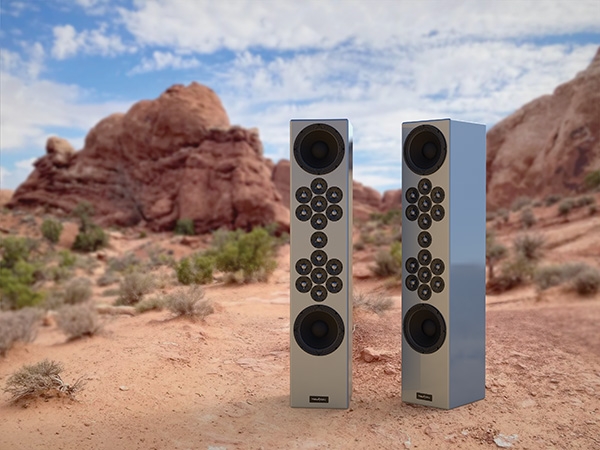
First off, if I'm spending $30,000 on a speaker, it better look ABSOLUTELY FABULOUS, and my subjective opinion is that this speaker looks like a giant box that's been painted. If it was some DIY project, I wouldn't complain, but at $30K, it's competing in some rareified air.

I personally think the Kef Blade 2 is more handsome. And because of it's looks, I think it would be easier to resell, if/when I get bored of it. (I always get bored of my toys.) The Blade 2 sells for $28K and is available at Best Buy.
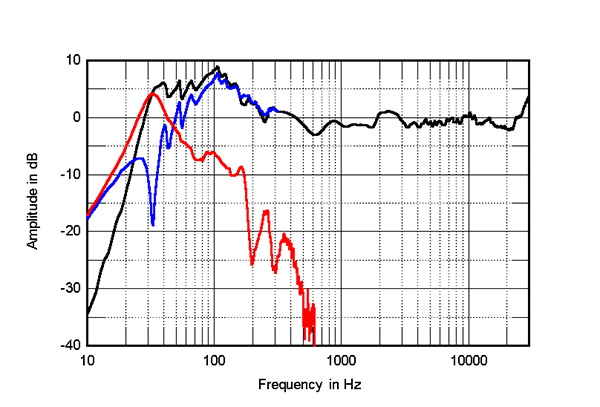
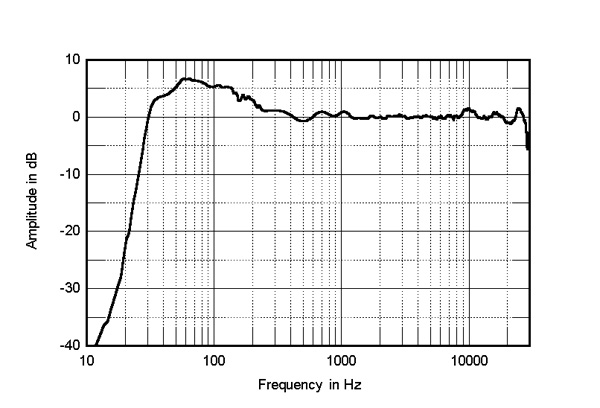
Here's the frequency response of the Tekton and the Kef, in that order. Although both have exaggerated bass, the Kef is much flatter in the frequencies where non-linearity is most audible. The Kef is also extremely easy to equalize because it's response is so smooth.
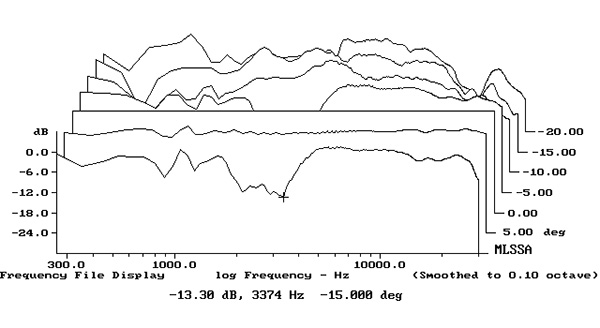
Tekton vertical polars courtesy of Stereophile
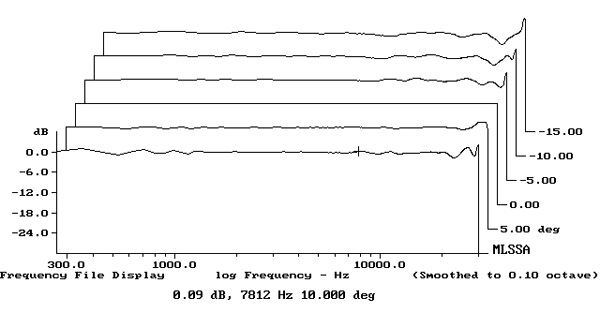
Kef vertical polars courtesy of Stereophile
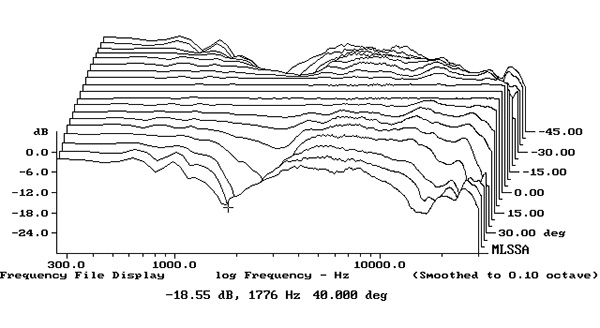
Tekton horizontal polars courtesy of Stereophile
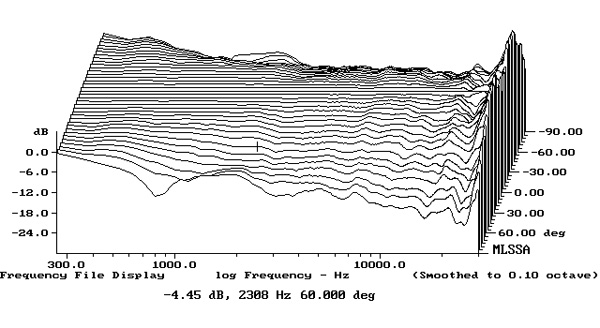
Kef horizontal polars courtesy of Stereophile
The thing that REALLY blows me away about the Kef, is how absolutely consistent it's polar response is. Ever since Geddes got me into waveguides, I've really found that what tends to make a speaker sound VERY GOOD in a real room is the polar response. For instance, the entire side of my living room is a sliding glass pocket door. My wife REALLY doesn't want any curtains or the like on that, because pocket doors are really trendy right now, and covering them up defeats the purpose. Picture this:
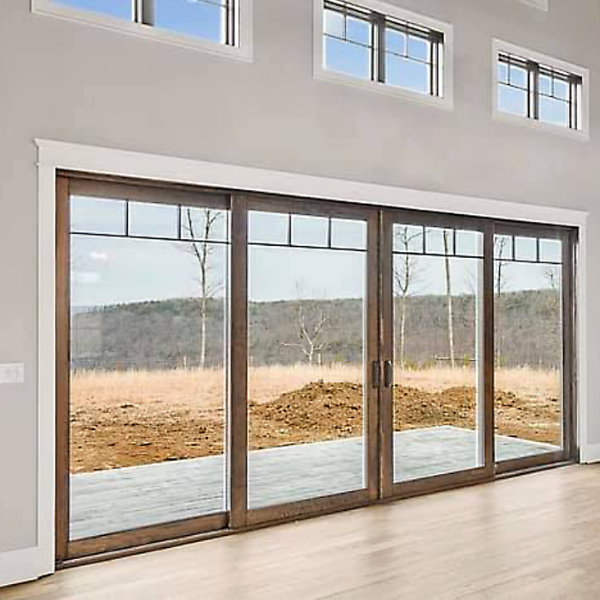
This wouldn't be the first time that I overanalyzed something. But here's my opinion on these two speakers:
The Summas that I used to run, they had a retail price of $10K iirc. (It's been sixteen years, I may be off.) It wouldn't be completely crazy for me to drop $30K on speakers. I've been working from home for twenty years, $30K isn't an outrageous sum of money to spend on something that you can use every day for ten years; that's $8.22 a day, not much more than a sandwich.
But if I'm dropping $30K on speakers, to get my wife to sign off on it, they better look almost as good as they sound. And at $30K for the Moabs, I'm just not feeling it. Just my opinion, it's subjective. But even if the two speakers looked identical, I think the Kef is a WONDERFUL example of performance that's way WAY beyond my capabilities.
When we talk about "quality of drivers," I personally think that "quality of engineering" is more important. Here's some measurements of a Dynaudio speaker from 26 years ago: https://www.stereophile.com/content/dynaudio-contour-30-loudspeaker-measurements
It's not TERRIBLE but it's not even in the same BALLPARK as what we're seeing in modern "commercial" designs. I also intentionally use the word "commercial" to denote companies like Kef, that have resources that DIYers can't even DREAM of.
And a big part of the reason I'm such a big supporter of folks like Erin and Amir is because they're really pulling back the curtain on this stuff, and they're providing data that really demonstrates the level of performance that's now possible in speakers. I think that in the past, depending on data was much more tricky, because Stereophile was just about the only consistent source of that data, and also some stuff that was occasionally done in academia, like Choueri's measurements.
Let's look at it:

First off, if I'm spending $30,000 on a speaker, it better look ABSOLUTELY FABULOUS, and my subjective opinion is that this speaker looks like a giant box that's been painted. If it was some DIY project, I wouldn't complain, but at $30K, it's competing in some rareified air.

I personally think the Kef Blade 2 is more handsome. And because of it's looks, I think it would be easier to resell, if/when I get bored of it. (I always get bored of my toys.) The Blade 2 sells for $28K and is available at Best Buy.


Here's the frequency response of the Tekton and the Kef, in that order. Although both have exaggerated bass, the Kef is much flatter in the frequencies where non-linearity is most audible. The Kef is also extremely easy to equalize because it's response is so smooth.

Tekton vertical polars courtesy of Stereophile

Kef vertical polars courtesy of Stereophile

Tekton horizontal polars courtesy of Stereophile

Kef horizontal polars courtesy of Stereophile
The thing that REALLY blows me away about the Kef, is how absolutely consistent it's polar response is. Ever since Geddes got me into waveguides, I've really found that what tends to make a speaker sound VERY GOOD in a real room is the polar response. For instance, the entire side of my living room is a sliding glass pocket door. My wife REALLY doesn't want any curtains or the like on that, because pocket doors are really trendy right now, and covering them up defeats the purpose. Picture this:

This wouldn't be the first time that I overanalyzed something. But here's my opinion on these two speakers:
The Summas that I used to run, they had a retail price of $10K iirc. (It's been sixteen years, I may be off.) It wouldn't be completely crazy for me to drop $30K on speakers. I've been working from home for twenty years, $30K isn't an outrageous sum of money to spend on something that you can use every day for ten years; that's $8.22 a day, not much more than a sandwich.
But if I'm dropping $30K on speakers, to get my wife to sign off on it, they better look almost as good as they sound. And at $30K for the Moabs, I'm just not feeling it. Just my opinion, it's subjective. But even if the two speakers looked identical, I think the Kef is a WONDERFUL example of performance that's way WAY beyond my capabilities.
When we talk about "quality of drivers," I personally think that "quality of engineering" is more important. Here's some measurements of a Dynaudio speaker from 26 years ago: https://www.stereophile.com/content/dynaudio-contour-30-loudspeaker-measurements
It's not TERRIBLE but it's not even in the same BALLPARK as what we're seeing in modern "commercial" designs. I also intentionally use the word "commercial" to denote companies like Kef, that have resources that DIYers can't even DREAM of.
And a big part of the reason I'm such a big supporter of folks like Erin and Amir is because they're really pulling back the curtain on this stuff, and they're providing data that really demonstrates the level of performance that's now possible in speakers. I think that in the past, depending on data was much more tricky, because Stereophile was just about the only consistent source of that data, and also some stuff that was occasionally done in academia, like Choueri's measurements.
A couple of points. The low frequency measurements in stereophile are uncorrected nearfield ones and so the low frequency rise includes the baffle step correction. At a typical listening position the KEF is going to be close to flat excluding room boundary effects whereas the Tekton would have a small bump. Including room boundary effects and whatever is done to control them the differences are likely to be largely irrelevant.
When I first started DIYing speakers I was laughingly told DIY speakers are worth about half the price of the drivers and perhaps a touch more if you make the effort to break into parts and discard the cabinets. It's still a reasonable rule of thumb although ebay, online promoting and the remarkable increase in value of some old hardware in the eyes of a few has changed things a bit. A fair few commercial audiophile speakers like the Tektons are pretty much DIY speakers with marketing and support. The KEFs less so because of the coaxial drivers and the cabinet construction but again the marketing and support is adding much if not most of the value. A competent experienced DIYer making a significant effort could likely get close to the performance of the KEFs and one making a modest effort could likely match the Tektons should they feel so inclined. The DIY speakers are still only going to be worth only a small fraction of the commercial equivalents to people other than the maker.
When I first started DIYing speakers I was laughingly told DIY speakers are worth about half the price of the drivers and perhaps a touch more if you make the effort to break into parts and discard the cabinets. It's still a reasonable rule of thumb although ebay, online promoting and the remarkable increase in value of some old hardware in the eyes of a few has changed things a bit. A fair few commercial audiophile speakers like the Tektons are pretty much DIY speakers with marketing and support. The KEFs less so because of the coaxial drivers and the cabinet construction but again the marketing and support is adding much if not most of the value. A competent experienced DIYer making a significant effort could likely get close to the performance of the KEFs and one making a modest effort could likely match the Tektons should they feel so inclined. The DIY speakers are still only going to be worth only a small fraction of the commercial equivalents to people other than the maker.
Many years ago there was a DIY trend to use many tweeters for midrange. I went through it, then I built plasma tweeters. The motivation was the mystique surrounding low mass diaphragms.
As a third point I was recently chatting with a poster who was leaning towards this speaker rather than this similarly priced one. One of these is a DIY project for a beginner with a modest budget while the other would be a challenge for an experienced DIYer with the budget likely to exceed the cost of the commercial product. There is a large difference in technical performance between the two speakers but this is not an important factor for many enthusiasts. The different things people value matters when it comes to assessing value for money when it comes to DIY speakers.
Since there seems to be a common theme. As a DIY builder do you care about resale value? I could care less I enjoy building and finishing my cabinets. If I scrap a speaker system I still can part out the network into my parts bins and I have the drivers to either store for a future project or sell.
So I don't see resale as a motivator at all. The fun is just building a speaker.
Rob 🙂
So I don't see resale as a motivator at all. The fun is just building a speaker.
Rob 🙂
The topic is good, but I really doubt the DIY guys can handle the truth. I work paralelly with DIY and comercial speakers for two decades. By saying work with them I mean I do not listen them at shows and then expressing my opinion. I either own them or borrow for a 2-3 months-listen in 2-3 diferent studios, disasemble, research how they are made. The most expensive speaker i disasembled was costing more than expensive sport car..
So that my facts gathered over those years (if those fact insult you and you feel better you can call them subjective thoughts)
Intro.since 2010 or so around highe end market went crazy - 50 to 65% expensive comercial speakers in reality is DIY in sheeps cloth. its became normal that person working with printers become high end speaker manufacturer in 6 month. Lack of R&D, lack of expierence ,incompetence, lead to medciore or bad designs which can be easily outperformed with clever DIY designs.
So by saying comercial good sounding speakers in this context I mean NOT this kind of designs.
I also leaving alone comercial speakers up to 10Keur. From that amount and up.
so
1) Usualy comercial speakers cost 5 to 7 times more than similar sized DIY oferings(if those DIY guys work for free this number rises even more). if you extract dealer markup(~40%) is still more expensive.
BTW Usualy not means always. I have witnessed expensive Accuton DIY speaker design (a "Clone" of Marten Coltrane) designed by very well known DIY guy ( i see many his DIY kits here on diyaudio discusing designs) was badly beaten by 10x cheaper and 25x times smaller sonus faber bookshelf. Soundstage size, projection, midrange texture, realistic palpable strings. Even the bass(up to 60hz was better). It was a six person(non diyers) opinion. I just set both speakers in room to perform their best.
2)there is strong relation on Axial frequency responseand origin of speakers. Nearly always flatter (and sometimes by high margin) on DIY speakers. I rarely find DIY speakes with uneven axial frequency respponse. And most natural and lifelike sounding comercial speakers have uneven axial frequency response.
3) I have yet to find any expensive DIY speaker (including ones using GOTO drivers) which can come close to good comercial design using much cheaper drivers. For example - avantgarde acoustics is quite good example of cheap drivers but good sounding speaker system-of course maintaining required minimum listening distance and setup in room).
4)Subjective sonics evaluation of DIY VS comercial speaker should be made by unbiased audiophiles which neither DIYers nor manufacturers. The results is predictable. I witnessed many of those tests over years. I also see lot of delusional pointless discusions on stereophile forums about 150 000usd speakers where (hidden) diyers says i can make better for 10% price. Yes they can make "better"(with diferent parameters) speakers. But it wont be recognized as better speaker by audiophiles. Most DIY'ers I argued can make everyhing but when i ask to what age grade audiophiles your designs aimed they look at me like I am alien. Lack of expierence in lateral disciplines, lack of thinking outside box leads to making speakers whose can not be sold for more than drivers price(sometimes even less).
I love DIY but truth may be hard to handle.Especialy in DIY forum.
sorry for typing errors, typing fast with small keyboard laptop and 2 fingers.
So that my facts gathered over those years (if those fact insult you and you feel better you can call them subjective thoughts)
Intro.since 2010 or so around highe end market went crazy - 50 to 65% expensive comercial speakers in reality is DIY in sheeps cloth. its became normal that person working with printers become high end speaker manufacturer in 6 month. Lack of R&D, lack of expierence ,incompetence, lead to medciore or bad designs which can be easily outperformed with clever DIY designs.
So by saying comercial good sounding speakers in this context I mean NOT this kind of designs.
I also leaving alone comercial speakers up to 10Keur. From that amount and up.
so
1) Usualy comercial speakers cost 5 to 7 times more than similar sized DIY oferings(if those DIY guys work for free this number rises even more). if you extract dealer markup(~40%) is still more expensive.
BTW Usualy not means always. I have witnessed expensive Accuton DIY speaker design (a "Clone" of Marten Coltrane) designed by very well known DIY guy ( i see many his DIY kits here on diyaudio discusing designs) was badly beaten by 10x cheaper and 25x times smaller sonus faber bookshelf. Soundstage size, projection, midrange texture, realistic palpable strings. Even the bass(up to 60hz was better). It was a six person(non diyers) opinion. I just set both speakers in room to perform their best.
2)there is strong relation on Axial frequency responseand origin of speakers. Nearly always flatter (and sometimes by high margin) on DIY speakers. I rarely find DIY speakes with uneven axial frequency respponse. And most natural and lifelike sounding comercial speakers have uneven axial frequency response.
3) I have yet to find any expensive DIY speaker (including ones using GOTO drivers) which can come close to good comercial design using much cheaper drivers. For example - avantgarde acoustics is quite good example of cheap drivers but good sounding speaker system-of course maintaining required minimum listening distance and setup in room).
4)Subjective sonics evaluation of DIY VS comercial speaker should be made by unbiased audiophiles which neither DIYers nor manufacturers. The results is predictable. I witnessed many of those tests over years. I also see lot of delusional pointless discusions on stereophile forums about 150 000usd speakers where (hidden) diyers says i can make better for 10% price. Yes they can make "better"(with diferent parameters) speakers. But it wont be recognized as better speaker by audiophiles. Most DIY'ers I argued can make everyhing but when i ask to what age grade audiophiles your designs aimed they look at me like I am alien. Lack of expierence in lateral disciplines, lack of thinking outside box leads to making speakers whose can not be sold for more than drivers price(sometimes even less).
I love DIY but truth may be hard to handle.Especialy in DIY forum.
sorry for typing errors, typing fast with small keyboard laptop and 2 fingers.
Last edited:
No. Nor have I ever spoken with a DIYer who cared about resale value.Since there seems to be a common theme. As a DIY builder do you care about resale value🙂
I think the question of "commercial vs DIY" is valid and interesting. However, most of the commercial proponents throw out Red Herrings and false assumptions. My favorite is always "if you take the cost of the builders time into account..." 🤣
Hey, we all have our perspectives 🙂I love DIY but truth may be hard to handle.Especialy in DIY forum.
Like everything in audio, I'd say DIY vs commercial depends....
...mainly on what you want.
For me, I want sound quality first and foremost, ......with a realistic SPL capability, that includes headroom for unclipped, uncompressed peaks, across the full spectrum.
All in all, I feel commercial home audio is severely handicapped in being able to compete with my DIY, for what I want.
Commercial is handicapped because:
Looks don't matter very much to me, that saves a ton of $$ to begin with. It also allows for more optimal driver placements. (Tighter c2c's for example.)
Passive speakers are a compromise IMSO. A real hit to SQ on anything large enough to meet my SPL & headroom requirements.
The number of active ways doesn't I need matter. Builds are typically 5-ways.
The number of active amp channels, one channel per way, doesn't matter. Processing complexity doesn't matter. Both appear to be sales issues for commercial home audio.
Size doesn't matter, commercial has to consider buyer's acceptance, and worse, WAF. Lower frequency pattern control rocks; it takes size.
So does sub power....takes size. Most commercial home audio floor standers / towers are bass anemic at any realistic SPL.
Latency doesn't matter, which allows linear-phase designs ala FIR. Again, seldom found in the commercial domain. An incredible tool for achieving flat mag and phase, both on and off axis.
It's pretty easy to whup commercial, really...for what I want!
(Resell never crosses my mind. I've refused on a number of occasions to sell any DIY, because I don't want to ruin a good hobby by letting it veer toward a business. 😛)
The answer to this thread's question is simple and logical.
DIY can be of such sound quality that 2 major driver and cabinet
manufacturers have decided not to supply the DIY market with
their driver offerings anymore, not counting automotive section.
People will get fed up with just about anything, when the time is right.
So will they change their opinion accordingly.
DIY can be of such sound quality that 2 major driver and cabinet
manufacturers have decided not to supply the DIY market with
their driver offerings anymore, not counting automotive section.
People will get fed up with just about anything, when the time is right.
So will they change their opinion accordingly.
- Home
- Loudspeakers
- Multi-Way
- How good are our DIY units compared to off the shelf stuff?
